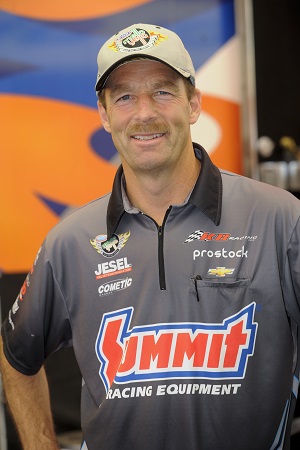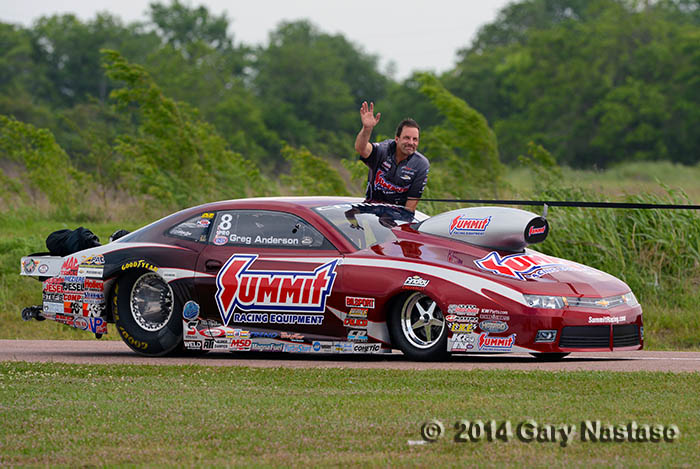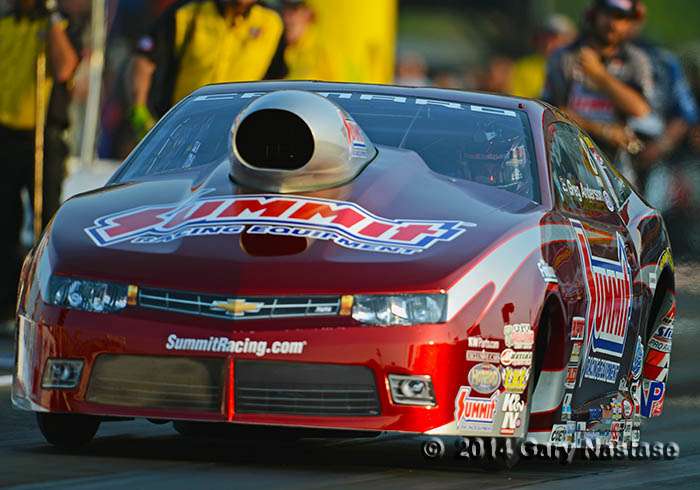ANDERSON’S DECISION TO HAVE HEART SURGERY SAVED HIS LIFE
 Greg Anderson’s heart would have exploded from excitement, literally.
Greg Anderson’s heart would have exploded from excitement, literally.
This was the reality driven home to the four-time champion following surgery to repair a bicuspid aortic valve in February.
For over fifty years, Anderson was a ticking time bomb and didn’t know it.
Three years ago, Anderson learned of his heart condition during a routine physical examination to renew his NHRA Pro Stock competitor’s license.
“I was at my family doctor’s office and then, while listening through the stethoscope he told me, ‘I think I hear a little heart murmur.”
Anderson, who admittedly knows the ins and outs of a 500-inch Pro Stock engine, immediately responded, “What’s a heart murmur?”
Anderson’s physician couldn’t confirm he had a murmur but did say he was going to send him to a local hospital for an echocardiogram.
The inquisitive Anderson responded, “What does that do?”
The doctor explained to him that the process essentially photographs the valves of the heart.
Anderson wasn’t prepared for the explanation of his ailment.
“He said that I had what is called a bicuspid aortic valve,” Anderson said. “He told me ‘It means we have to replace your aortic valve.’”
A bicuspid aortic valve is a condition where instead of having three leaflets, a patient has only two, causing irregular blood flow.
“It doesn’t flow the blood linearly, it comes shooting sideways,” Anderson explained. “It’s sort of like holding your thumb on a garden hose and the water goes shooting out the side.”
The doctor was concerned by lack of blood flowing through the valve and couldn’t determine how much blood was flowing back though it on the closing cycle [or regurgitation]. The main artery, also known as the descending artery, had been anuerized from the abnormal flow of blood.
“They were afraid the artery would burst,” said Anderson. “He told me we needed to replace it.”
Anderson said he responded unlike the doctor expected.
“I told him, ‘you mean I’ve lived with this all of my life and if I don’t replace this now, I’m gonna die?’”
Anderson, who was preparing to go to a national event, challenged the doctor to tell him if it was an immediate life or death situation or if it could be dealt with at a later time.
Anderson then underwent a heart cath which revealed the artery was flowing fine. The size of the artery tube was 4.6, ballooned from a normal two-inches.
“The doctor said once it passes 5 centimeters, they get scared,” said Anderson. “They will have to go in and fix it.”
The doctor suggested they check every three months to monitor the size of the aortic valve.
 Anderson raced with no problem, maintaining a regular check-up regimen.
Anderson raced with no problem, maintaining a regular check-up regimen.
“I just really didn’t think anything was going to change, I had no worries about it,” said Anderson.
Last February, the size increased to 5.1.
“The doctor told me we had to replace it,” said Anderson. “I told him I was a week away from starting the season, and I couldn’t do it. The doctor pleaded with me to get the procedure done because at any time it could explode with higher blood pressure associated with driving a race car.”
Anderson said he reasoned with the doctor, pointing out his daily exercise routine and the fact he felt fine, as reasons to delay the surgery. After an hour of coaxing, he believed the doctor was either worn down or actually saw the situation from his point of view.
Anderson went home and explained the situation to his wife and parents. They weren’t as easy to convince. In fact, as Anderson said, there was no convincing them he needed to race.
“I had to realize what was more important,” Anderson said. “The doctor said he knew I’d be back. The only reason he said he allowed me to leave is because he knew I’d be back.”
Anderson figured his strenuous workout would determine when surgery was necessary.
“I figured it would tell me when it was time,” said Anderson. “I felt nothing.”
Faced with the prospect of being sidelined for three months, Anderson made the call to Summit Racing Equipment, his sponsor, who confirmed he needed to be more concerned with his health than racing.
“I came to grips with it, but it was still a tough decision to make,” said Anderson. “You have to think about your family.”
Anderson’s surgery included replacement of the defective aortic valve with one from a cow.
Anderson realized afterward how he’d cheated death and how Pomona could have been the last race of his life.
“When I came out of the surgery, he told me I absolutely wouldn’t have made it through the first race,” Anderson said. “The doctor said the artery was so weak when he touched it, it just fell apart. The lining had been stretched so far and so thin. It wouldn’t have lasted through one more blood pressure spike.”
Anderson then realized his own well-being needs to come before racing.
“I feel very fortunate, the luckiest man in the world,” said Anderson. “I was this close to making the wrong decision because we, as racers, cannot sit out of a race. That seemed more important, to race. And, my family talked me into the right decision. I was too stupid to make the right decision.”
Even though Anderson had studied all about the heart surgery he was prepared to experience, he wasn’t prepared for the aftermath. He lost a lot of blood during the surgery and as a result, was hampered in his initial recovery.
This led the hospital staff to believe he’d suffered a stroke during the procedure.
“I’d look at them and want to talk, but the words wouldn’t come out right,” Anderson revealed. “They’d ask my name and I’d respond, ‘hockey puck.”
 “I knew what I wanted to say, I just couldn’t answer. This went on for two days and they told my family I’d likely had a stroke and would never be the same. This went on for two days. They finally took me down and did a CAT scan and came back negative for a stroke. On the third day, I was back and answered every question correctly. It was rough on my family and I was laying there saying to myself, ‘how could I have become the .01 failure?”
“I knew what I wanted to say, I just couldn’t answer. This went on for two days and they told my family I’d likely had a stroke and would never be the same. This went on for two days. They finally took me down and did a CAT scan and came back negative for a stroke. On the third day, I was back and answered every question correctly. It was rough on my family and I was laying there saying to myself, ‘how could I have become the .01 failure?”
Little did Anderson know his persistence with his doctor also led to an early return to racing, one race earlier.
“Right up until the surgery, as I was rolling in, I was reminding the doctor just how much of a trauma it was for me to miss three months, and whatever he could do to get me back on the track quicker and if I miss one more race than expected, it’s the world to me. They look at you like you’re crazy because in the grand scheme of things does it really matter. But they don’t see life like we do, and the passion we have for this sport and why we cannot just sit around for three months. I asked him to cut my chest with a thinner saw blade if he could.”
Mindful of Anderson’s occupation, the doctor rejoined his split sternum with titanium plates instead of just the standard wiring. He missed only five races instead of six because of the doctor’s mindfulness.
Anderson believes his longshot battle to reach the Countdown to the Championship could come down to his early return.
“Those twenty or thirty points from Houston might be the difference in making the playoffs,” said Anderson.
Now 20 pounds leaner, the experience has taught the physically fit Anderson, a headstrong competitor, that he isn’t invincible.
“That’s tough to accept,” said Anderson. “I’m glad it’s over and I learned I can fall into that .01. Now I learned you have to be serious about your health. I learned quickly that a heart attack can come without warning.”
The act of cutting and pasting articles from this publication to a message board is a clear copyright violation as is pulling photos to post on social media sites. All articles and photography published in CompetitionPlus.com are protected by United States of America and International copyright laws unless mentioned otherwise. The content on this website is intended for the private use of the reader and may not be published or reposted in any form without the prior written consent of CompetitionPlus.com.





































